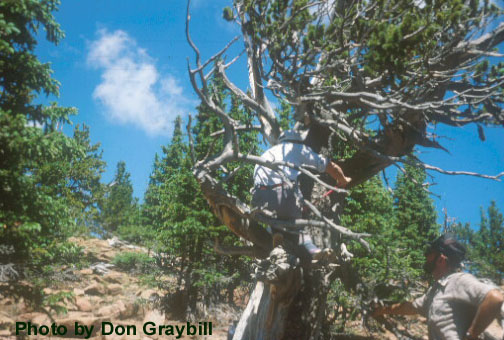Many of you have probably read about the disputes over temeprature histories like Mann’s hockey stick chart. I thought you might be interested in how some of these 1000-year long proxies are generated. There are several different approaches, but one that Mann relied a great deal on is measuring tree rings in bristle cone pine trees. Here is a picture of a researcher taking a core from a very old tree that is then sent to a lab to have it’s ring widths measured.
In theory, these ring widths are directly proportional to annual temepratures, but there are a lot of questions about whether this is really true. Other factors, like changing precipitation patterns, might also affect ring widths, and there may be reasons why the scale could change over time. Remember, we only have a few decades, at most, of good temperature data to scale growth in a tree that goes back over a thousand years. In fact, scientists are finding that, more recently, tree ring proxy data for current growth is diverging from surface temperature data, meaning either that surface temperature data is flawed or that they don’t really understand how to scale tree ring data yet. Interestingly, and as a sign of the health of climate science, researchers have reacted to this problem by … not updating tree ring proxy databases for recent years. That’s one way to handle data that threatens your hypothesis — just refuse to collect it. Much more on proxy histories here.


For your interest: Interest in global warming is waning as evidenced from online search traffic, even with Gore’s latest Nobel win.
http://www.time.com/time/business/article/0,8599,1672516,00.html
Forty-some years ago, I did a school science project on tree-ring samples, with help from my dad, who has a masters in Biology. I took cores from some living trees (just second-growth Michigan hardwoods and softwoods generally under 100 years old) and tried to correlate the variations in ring thickness with weather records. IIRC, rainfall had as much influence as temperature – even in Michigan where it never gets really dry – and there were also considerable variations unrelated to anything in the weather records. Diseases, insect infestation, and competition from the other plants for sunlight or root nutrients all play their part, too.
I begin to suspect that the problem is that Global Warm-mongers KNOW that we’ve been in a mild spell (very possibly correctly) and have been frustrated at how hard it is to prove conclusively. Thus their endless “correcting” of measurements, faking of curves and suppressing of embarrassments; thus my becoming a Global Warming Cynic.
another major factor influencing the growth of bristle cone pine (and nearly all plants) is CO2 levels. keep in mind that CO2 is plant food. commercial greenhouses run their atmospheres at more like 800-1000 PPM to make the plants grow more rapidly.